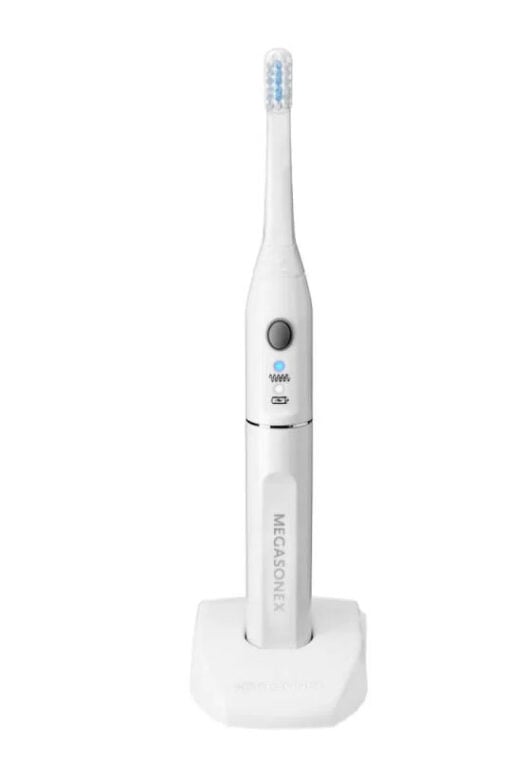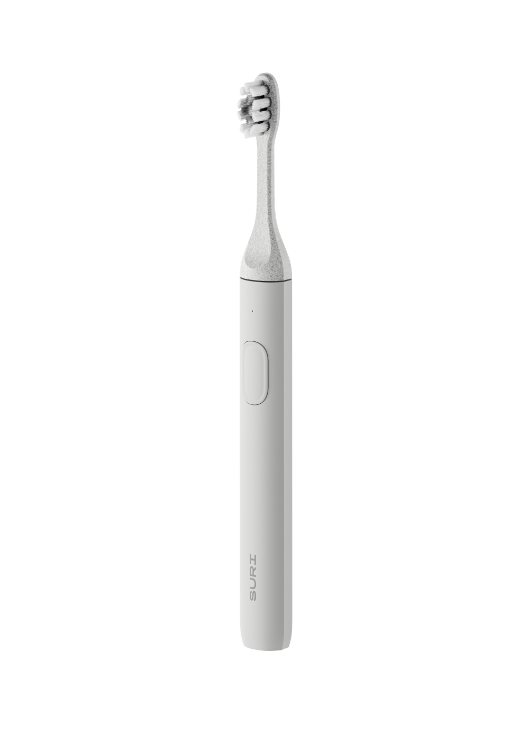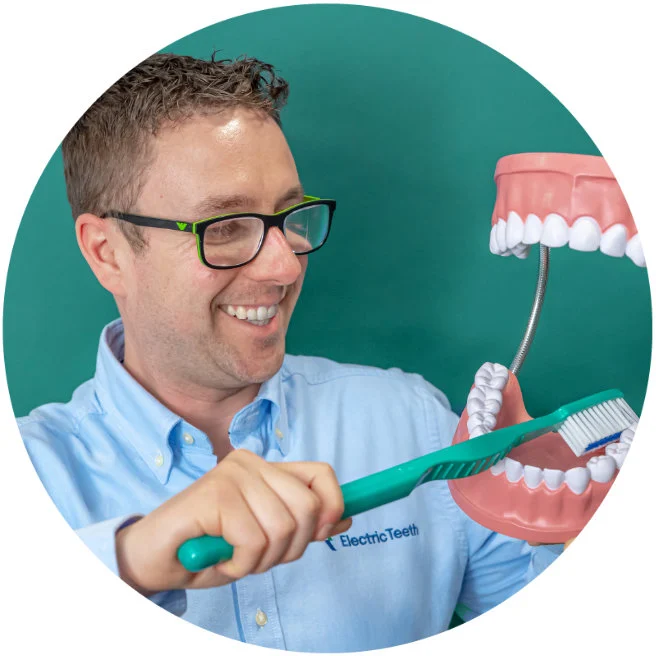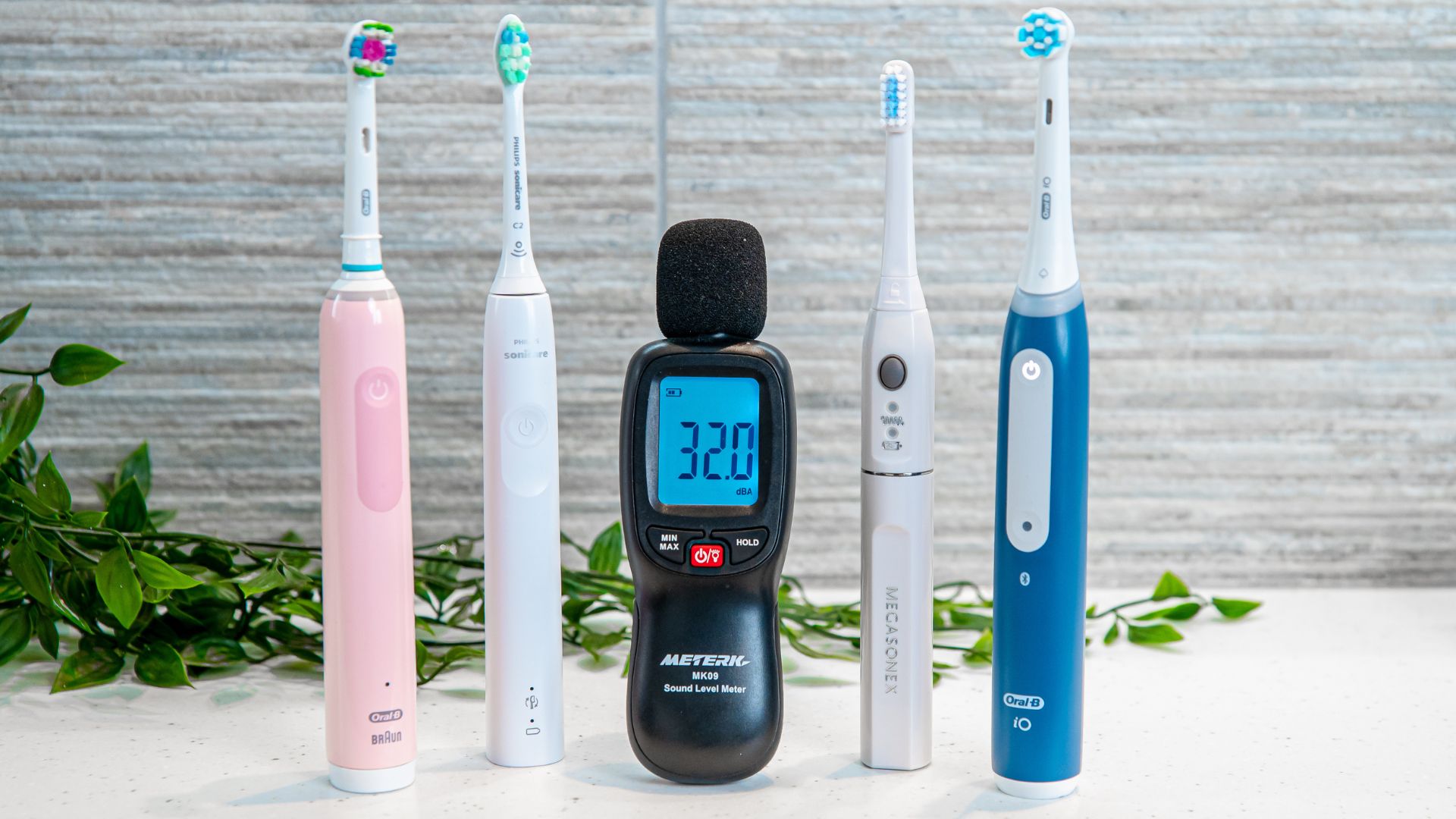
Our verdict
The quietest electric toothbrush is the Oclean X Pro Elite producing 48 decibels (dB)*.
My top electric toothbrush pick overall remains the Oral-B Smart 2000. It is 20 dB louder producing 78 dB.
Of course, a manual toothbrush is the quietest and can clean the teeth just as well if used correctly.
|
Our Choice

|
Our Choice

|
|
|---|---|---|
| Decibel reading | 78 | 48 |
| Amazon | $89.97 | - |
| Oclean | - | View price |
Despite all the technical innovations that we have experienced, electric toothbrushes are not yet silent.
In fact, many people are surprised at just how noisy some brushes can be.
I am not qualified to explain precisely how everything inside a toothbrush works. However, it is typically the brush heads and the motor that generates the noise we hear. These are the key moving parts.
A motor inside the toothbrush handle takes electrical energy stored inside the battery and converts it into mechanical energy. It transfers this energy to the brush head via a shaft that connects to the motor and a series of cams and gears.
If you remove a brush head from an electric toothbrush, you will often see this shaft. It is normally metal and extends from the top of the handle.
The back and forth or rotating movement of the bristles on the brush head is what is required to clean the teeth. Typically it is this movement that is loudest.
Within the motor are a number of different parts. Some of these parts move or come into contact with other moving parts for it to function. The physical movement of each part causes the air inside to vibrate. The vibrations in turn create a sound we hear.
The actual design of the motor and the brush handle can have an impact on how loud the sound is. A more hollow handle for example may allow the sound from the motor to amplify as there is more space for the soundwaves to move around in.
Like many mechanical devices, over time, repeated use and wear will have an impact on the motor. Brushes and bearings can become worn. Points that may have been greased have dried up. Together these things can mean that the motor cannot work as efficiently as it once did. The consequence then can be that it produces more noise.
Sonic toothbrushes are quieter
As a general rule, sonic electric toothbrushes, like those produced by Philips Sonicare, tend to be quieter.
That is when you compare them to the oscillating-rotating brushes from the likes of Oral-B.
This is because they vibrate at much higher frequencies.
The chart topping Oclean X Pro Elite, is a sonic toothbrush.
The Oral-B toothbrushes have a much more mechanical sound compared to the softer humming noise that a sonic toothbrush produces.
It can vary from one model to another, but typically the noise difference between these 2 brands is in the region of 10 decibels. Oral-B being the louder of the two.
In 2020, Oral-B introduced the iO which uses a different motor to the vast majority of their electric toothbrushes. This new motor and the way in which it moves the brush head has resulted in a quieter toothbrush.
However, the iO is still louder than most sonic toothbrushes, but it is approximately 2-12 decibels quieter than most other Oral-B brushes (subject to model).
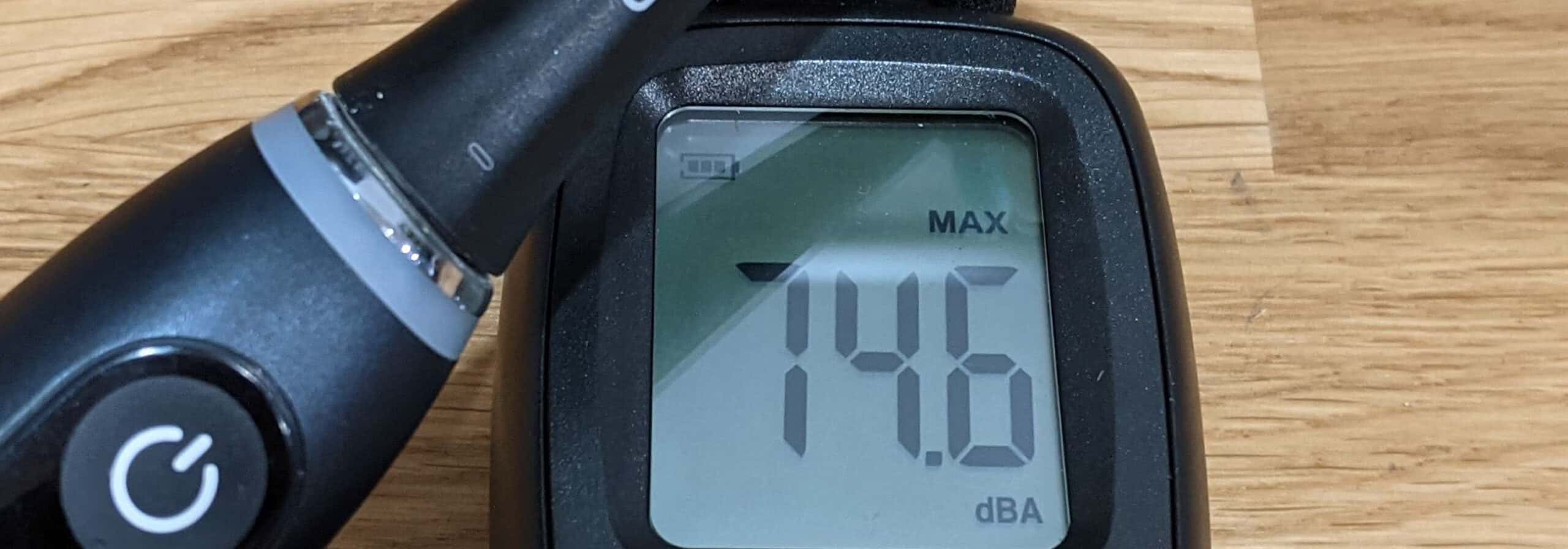
Paying more for an electric toothbrush doesn’t mean a quieter toothbrush. In fact, some of the quietest options are the cheaper ones.
Having a bearing on the sound can be the power or number of brush head movements.
A sonic electric toothbrush generally produces somewhere in the region of 31,000 brush strokes per minute. That is over 500 brush strokes per second.
An oscillating-rotating electric toothbrush generates anywhere between 7,600-10,000 oscillations per minute. That equates to 127-175 movements per second, subject to model.
In addition, Oral-B electric toothbrushes produce an additional movement known as pulsations which range from 20,000-48,000. That is a further 333 to 800 movements per second, subject to model.
It is this repeated back and forth movement in the head that cleans the teeth. But it is this which to creates some of the noise. Just how much depends precisely on the mechanism used to generate the movements.
In addition to the motor you have other parts such as cogs and gears that all contribute to the operation of a toothbrush and are all susceptible to having an impact on the noise too.
I have used and handled over 100 brushes and for the most part all of those brushes operate within a similar sound range.
As I have already said Oral-B tends to be the noisiest. Sonic toothbrushes tend to be quietest.
Only on a couple of occasions has a product stood out for being particularly quiet.
I can’t say one model has stood out for being particularly loud. That ‘loud’ categorization applies to Oral-B as a whole.
This is certainly a generalized statement, but I feel it highlights the difference appropriately. Imagine you are brushing your teeth in the bathroom next to a bedroom in which someone is sleeping.
With a sonic toothbrush, you could likely leave the doors open and not wake that person in the room next door. With an Oral-B brush you would likely want to shut the door so as not to wake them up.
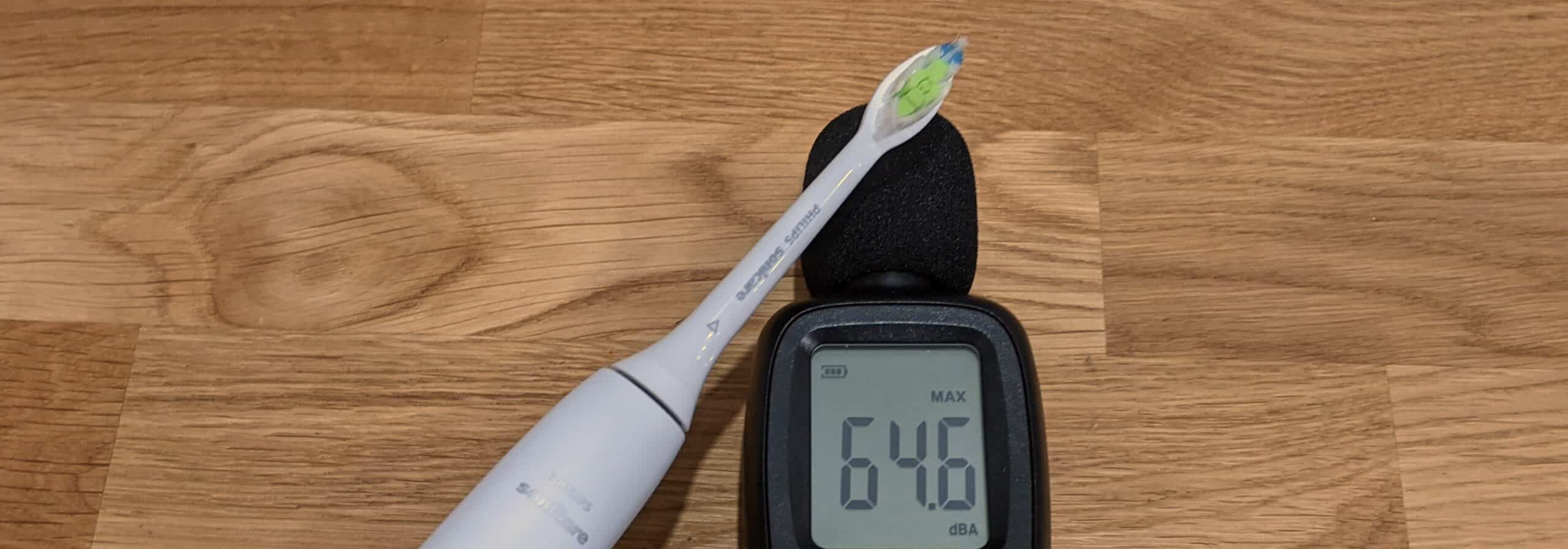
Muting/deadening the sound
It is possible to reduce the sound of the toothbrush.
The most common suggestion given is to wrap your toothbrush in something. Preferably something soft, yet thick.
This wrapping around the toothbrush is designed to deaden the sound. A towel, wash clothes or t-shirt are examples of what you could use.
This is often a cheap and convenient way to suppress some of the noise.
The reality is that none of these work very well. I actually found it to be more hassle than it is worth. But, in certain situations, it may well be better than nothing.
In my own testing, I took an Oral-B Smart 1500 that produces 75 decibels and wrapped it as best as I could with a towel. The sound it produced dropped by just 5 decibels to 70.
With a Sonicare ProtectiveClean 6100 it dropped from 62 to 59 decibels.
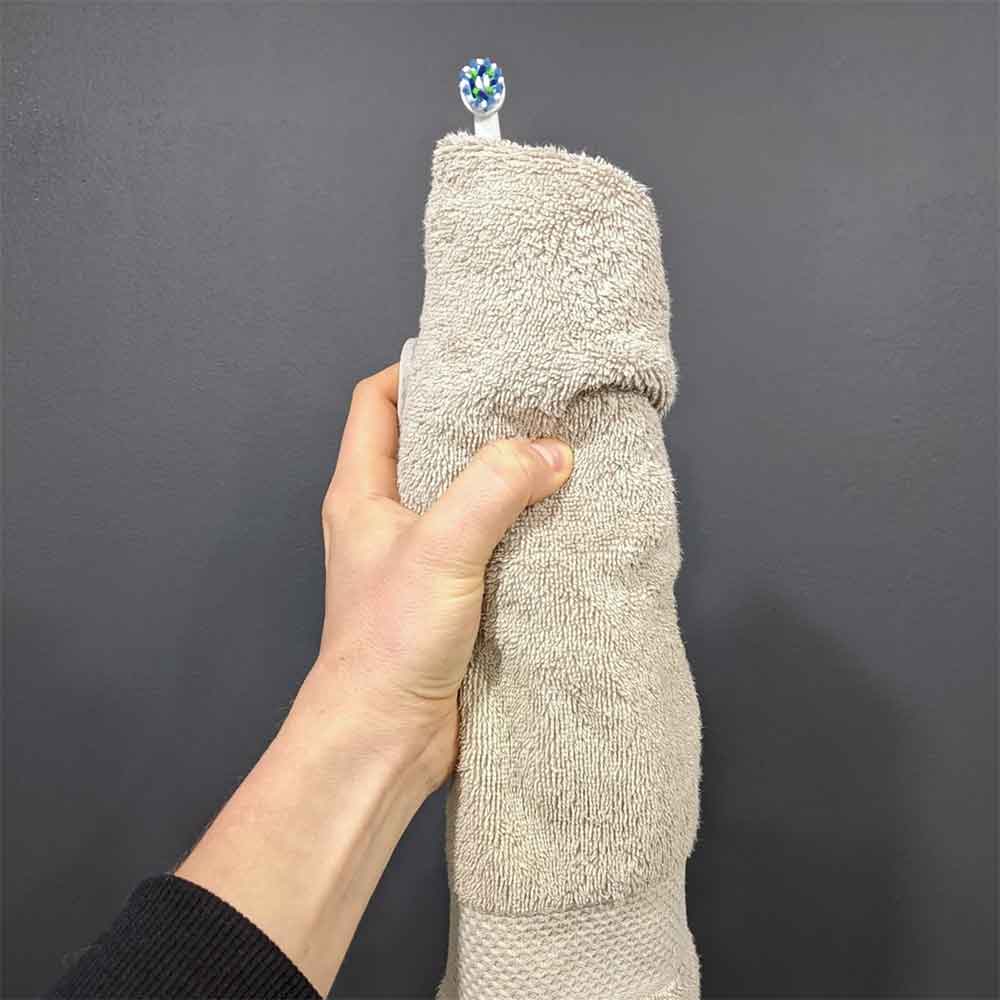
It is all very well wrapping the toothbrush in something, but it can make it harder to actually hold onto. And it can make it more difficult to move around the mouth.
It can hide other alerts the handle might give. One example is that the visible pressure sensor will not be visible when wrapped in a cloth.
You will also want to bear in mind that whatever you wrap around the brush you want to be clean as it's going near your mouth. You also want to ensure it does not interfere with the movement and operation of the brush. You don’t want a stray thread getting caught up in the brush head mechanism.
It is not a permanent solution either. In fact I know of no permanent solution to make the brush quieter other than switching to a sonic toothbrush.
How loud are toothbrushes?
The following table lists out the noise (in decibels (dB)) of the quietest and loudest electric toothbrushes.
Also included are some of the most popular models on the market today.
I have intentionally not listed every single model I have had hands-on with. If I did, it would make for a very long list.
In most instances the models are within a few decibels of each other.
A Philips Sonicare ProtectiveClean 4100 is as loud as a Sonicare ProtectiveClean 5100 for example.
I will keep this list as up to date as possible. If a particularly loud or quiet brush should be made available I will include it.
To help give some comparison to everyday life.
- 80dB = Busy street or an alarm clock
- 70dB = Busy traffic or a phone ringtone
- 60dB = Normal conversation at 3ft
- 50dB = Quiet office or quiet street
- 40dB = Quiet residential area or a park
- 30dB = Quiet whisper as 3ft or a library
|
Oclean X Pro Elite
|
|
Megasonex M8S
|
|
SURI S1 Toothbrush
|
|
Quip Adult Electric Toothbrush - Battery
|
|
Philips Sonicare 1100 Series
|
|
Philips Sonicare 3100 Series
|
|
Philips Sonicare 2100 Series
|
|
Philips Sonicare 4100 Series
|
|
Philips Sonicare ExpertClean 7300
|
|
Oral-B iO Series 3 (iO3)
|
|
Oral-B iO Series 4 (iO4)
|
|
Oral-B iO Series 5 (iO5)
|
|
Philips Sonicare DiamondClean 9900 Prestige
|
|
Oral-B iO Series 9 (iO9)
|
|
Oral-B Pro 500+
|
|
Oral-B Vitality
|
|
Oral-B Smart 2000
|
|
Oral-B Genius X
|
|
Burst Original Sonic Toothbrush
|
It is not possible to test every toothbrush that exists on the market today. So, yes, theoretically there may well be a quieter or louder brush available that might not be on the list. As a general rule, I am including products that are more widely sold and available to the vast majority of people.
How I measure the sound?
I place the toothbrush 6 inches away from a decibel meter. The toothbrush is held in my hand with a light grip. I turn the toothbrush on and run it through all cleaning modes and intensity settings available.
The decibel meter can measure the minimum and maximum sound. I take the maximum noise it produces as the decibel reading for my list.
It is, therefore, possible that the brush may operate a couple of decibels quieter than I have listed. But this may apply to a specific mode and intensity setting.
For example, if it produces 50 decibels in the standard clean mode, but 53 in the whitening mode, it is the 53 decibels that I record.
The meter will also register any button clicks.
I do not record the sound if the pressure sensor is activated. Some brushes might be louder or produce a different sound if excess pressure is detected. I exclude this to keep things fair.
I try to eliminate exterior factors and keep things consistent. But please not this is to be used as a guide only.
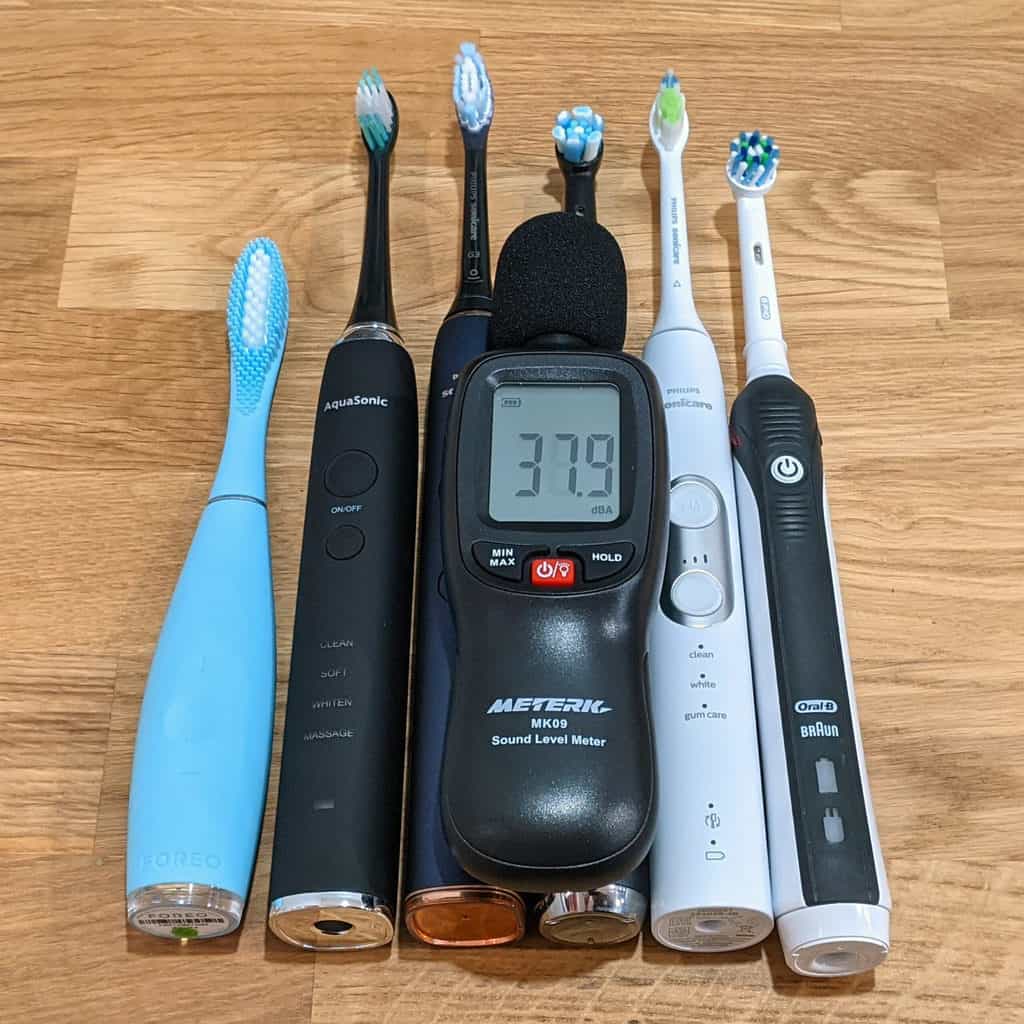
Other factors affecting the noise
Brush head
It is the brush head that produces a large proportion of the noise. It is therefore important to consider the brush head that you use.
Not all brush heads are created equal.
My advice is to stick with the manufacturer's original brush head. Whilst this might not necessarily be the quietest, typically it will be. It will be of a good quality and not affect the performance of the clean.
More cost effective brush heads from other companies can be made to different standards. The construction will possibly be different and the fit to that handle might not be quite as snug.
This can mean the noise produced is greater than when the manufacturer original is fitted.
Putting the sound aside, the overall cleaning performance and longevity of the brush head may also not be as good.
Manufacturers own brush heads or not, it is important to replace your head approximately every 3 months. This is for hygiene reasons, but also because parts inside the head can potentially wear. Extended usage times may result in more noise.
Cleanliness
It might seem silly, but keeping your brush clean will help.
Dried toothpaste and gunk in and around the head as well as around the shaft can affect the performance. It may cause the brush head not to move quite as it should. Parts may not travel as freely or their path of movement might be disrupted in turn affecting the noise and efficiency with which they operate.
After each use, rinse the toothbrush head and handle and if possible dry off with a towel or at worst leave it in a well ventilated space.
If the brush does get a buildup of muck that needs removing, take some time to do the best job you can to keep it clean.
Damage
Most toothbrushes will in their life suffer the odd fall or may incur a bit of damage, be that intentional or not.
The brushes are designed, as best as possible to survive such a life, but they are not infallible.
The better the condition of the toothbrush the better it will perform, so do try to take care of it.
A fall from even a few inches could potentially cause a cable to come loose or a part to become misaligned inside the handle.
In many cases, there are microscopic tolerances and the smallest misalignment can cause parts to perform incorrectly or not move freely thus affecting the performance and potentially the sound.
If you notice any strange sounds or odd performance from your brush it may well pay to get it inspected. Do this if you can within the warranty period to limit any potential costs.
The age of the brush
As a general rule the average toothbrush appears to last around 5 years. Although many last a great deal longer.
Older models are more likely to make more noise, although this is not always the case.
Typically there shouldn’t be too much noise generated by the handle itself. But, with repeated use parts can wear and you may experience more noise from the handle.
Electric toothbrushes for the most part are not designed to be serviceable at home.
Authorized repair agents can repair them. The reality is it tends not to be economically viable.
If a toothbrush is old and making a lot of noise, it is best to replace it. Recycling the old one of course.
Battery compartment
It is not all that common, but those electric brushes with removable batteries might create a bit more noise. There tends to be a little more room within the body, allowing for more vibration and movement. Batteries can rattle causing a frustrating sound.
Open up the battery casing and make sure the batteries are making good contact and are as snug as they can be. Ensure any battery caps are screwed or pushed on as securely as they can be.
The room
Whilst it doesn't directly affect the actual sound that the brush itself makes, it can affect the perception of the sound.
A bathroom with lots of hard tiled and glass surfaces for example is going to make the sound seem much louder than if you were brushing your teeth in a room filled with sound absorbing soft furnishings.
Soft items like towels, dampen the sound. There is less reverberation of the sound waves and less echo.
I am not suggesting going to stand in the closet to brush your teeth, but you get the point.



